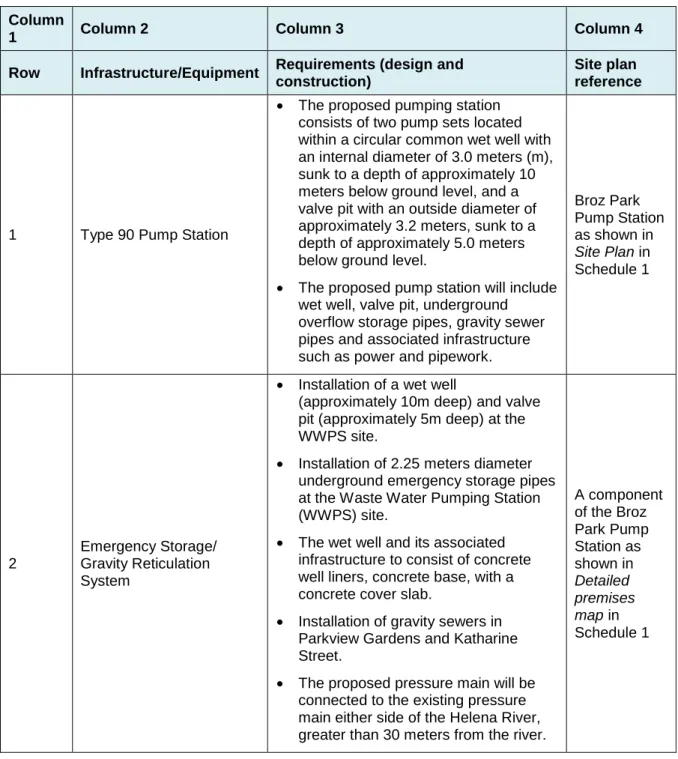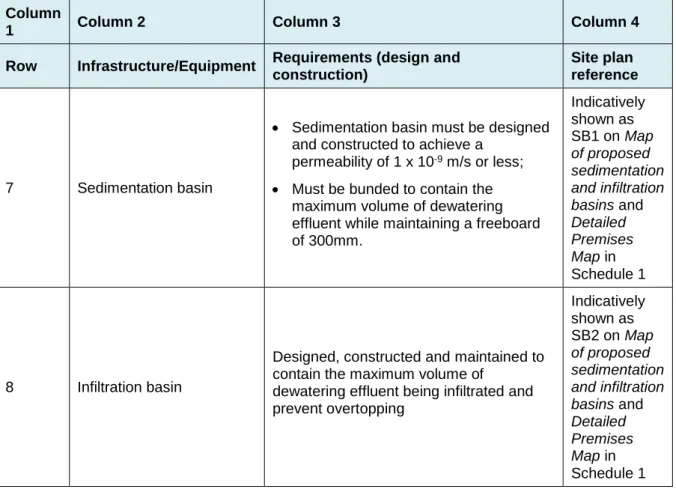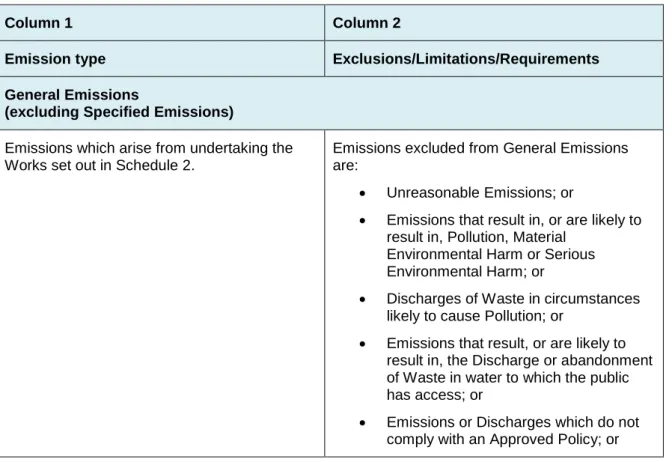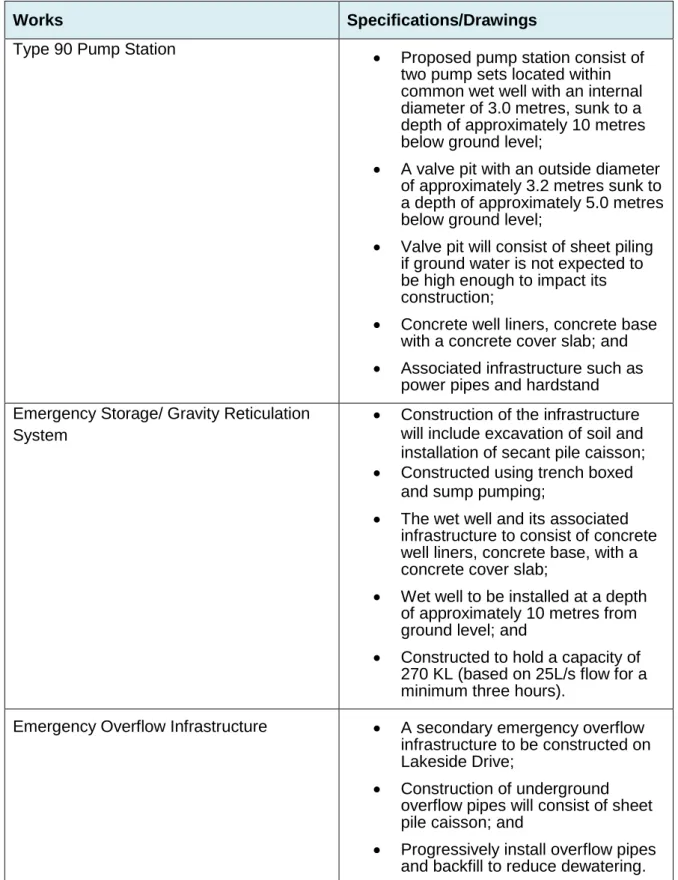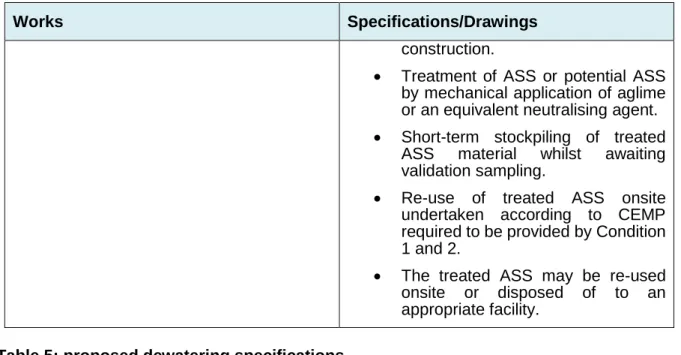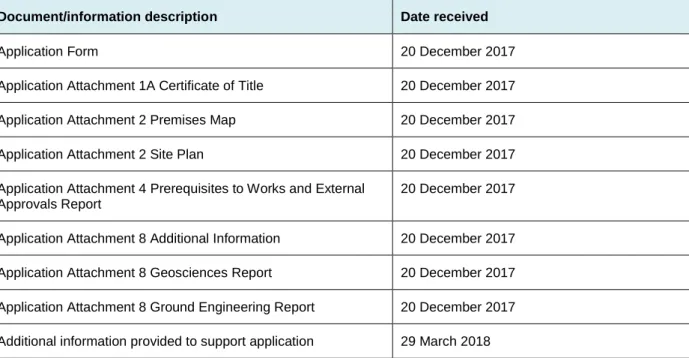The holder of a works authorization may apply to change the conditions of this works authorization in accordance with section 59 of the European Parliament Act. The Director-General may suspend or revoke this approval of works in accordance with section 59A of the European Parliament Act.
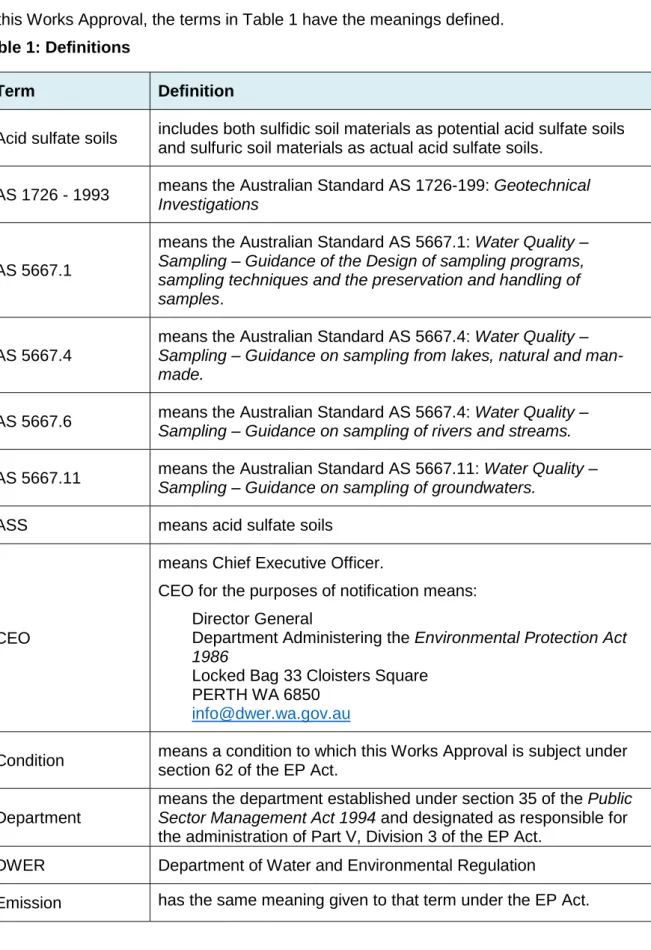
Dewatering management
Treated ASS or PASS should be reused on site only after validation sampling confirms that neutralization has been achieved. When ASS or PASS is disposed of at a licensed landfill, the work approval holder must provide receipts or other records of receipt from the appropriate authority.
Groundwater monitoring requirements
The Work Approval Holder must maintain accurate spatial tracking of volumes of ASS or PASS during the treatment process to ensure that soil treatment can be properly validated. Where ASS or PASS is disposed of to a licensed landfill, the Work Approval Holder must provide receipts or other acceptance records of the relevant. disposal facility, including details of the total amount of ASS or PASS material taken to the chosen facility, within the initial closure report required under condition 23.
Surface water monitoring requirements
Every week during dewatering operations and conducted on a quarterly basis for a period of six months after completion of dewatering operations.
Dewatering monitoring requirements
Reporting
Decommissioning
Closure reporting
A discussion of any potential risks to human health or the environment; and A discussion of any corrective measures required. Within one month of completion of the groundwater and surface water monitoring required by Conditions 18 and 19 respectively, the Works Approval Holder shall provide the CEO with a post-dewatering closure report containing, but not limited to:. a) the results of the groundwater monitoring program (plus surface water body monitoring program where applicable), with particular emphasis on trends in water quality (graphs of water quality variations with time should be presented to aid the identification of trends;.
Emissions
Emissions or releases that are the subject of offenses under regulations made under the European Parliament Act, including materials released under the Environmental Protection (Unauthorized Discharges) Regulations 2004.
Record-keeping
Maps Site Plan
Premises map
Detailed Premises Map
Proposed groundwater bore map
Existing groundwater bore map
Map of proposed sedimentation and infiltration basins
Works
Dewatering of wastewater to be discharged into a sedimentation basin near the pump station location. Waste water in the sedimentation basin must be dosed with lime to neutralize any acidity and must be monitored as specified in Appendix 6.
Site layout
Reuse of treated ASS on site undertaken according to CEMP required by condition 1 and 2. The treated ASS can be reused on site or disposed of to an appropriate facility.
Application for Works Approval
Decision Report
Definitions of terms and acronyms
As of 1 July 2017, the Department of Environment Regulation (DER), the Office of the Environmental Protection Authority (OEPA) and the Department of Water (DoW) have been merged into the Department of Water and Environmental Regulation (DWER). The DWER was established under section 35 of the Public Sector Management Act 1994 and is responsible for the administration of the Environmental Protection Act 1986 together with other legislation. Premises refers to the premises to which this decision report applies, as specified at the front of this decision report.
Purpose and scope of assessment
- Application details
Background
6 In the event of system failure, there is the potential for discharge from the pumping station to enter the tributaries to the Swan River. Therefore, the pump station is considered to be a Category 85A Prescribed Premises as defined in Schedule 1 of the Environmental Protection Regulations 1987 (the EP Regulations) and as shown below in Table 3. The premises have not previously been approved or registered as a Prescribed Premises. under Part V of the Environmental Protection Act 1986 (the EP Act).
Sewage Pumping Station: Premises where sewage is pumped (other than to or from septic tanks) and where waste discharge from the station may enter the Swan River or Canning River.
Overview of Premises
- Justification
- Infrastructure
- Construction
- Operation
The proposed pressure main will connect to the existing pressure main on each side of the Helena River, more than 30 m from the river. A secondary emergency overflow point will be constructed at Lakeside Drive to connect the existing sewer system (from existing sewer inlet W3749) to the existing piped stormwater system. Future emergency storage tanks will be provided to ensure there is a minimum emergency storage time of three hours in accordance with Water Corporation standards.
Excavation of the valve pit and emergency storage tank will take place to a depth of approximately 2.5 meters and 5 meters below ground level (m bgl), and the excavation of the wet well will take place to a depth of approximately 10 m bgl. In the application, it is stated that the waste water from the proposed sewage treatment plant will be pumped through the pressure main DN250 to the existing sewage treatment plant located on Stareja poti. The proposed pressure main will discharge to the proposed outfall access chamber on Katharine Street and waste water flows will be directed to the existing WWTP via the proposed DN300 gravity sewer.
Legislative context
- Contaminated sites
- Other relevant approvals
- Part V of the EP Act
2 The applicant will not undertake any construction work within 30 meters of the Helena River to prevent impacts to the Helena River and to prevent disruption of Aboriginal Heritage sites within the river system. Two overflow points, one located at the existing WWPS and the other connected to the existing storm water drain within Lakeside Drive should be used in an emergency. 3 The applicant proposes to take the water connected to the central pump valve and the well at a rate of 3 L/s for 14 days and not more than 3,640 kL.
Based on information provided in the applicant's dewatering management plan (discussed further in section 8.7), dewatering activities associated with the storage tanks are expected to occur at a rate of 11 l/s over a 42-day period, with a total withdrawal of 39,900 litres. cl. Additional information provided by the Applicant in April 2018 indicated that it was uncertain whether a dewatering permit would be required, as the construction method had not yet been determined. The applicant has communicated that the project's civil engineering contractor will apply for a permit if required.
Consultation
These activities do not qualify for an exemption and a permit for the intake of water may be required under the RIWI Act.
Location and siting 1 Siting context
- Residential Premises
- Specified ecosystems
- Groundwater and water sources
- Soil type
A residential road Parkview Gardens runs south of the premises and further residential roads Lakeside Drive, Katherine Street and Elder Way are along the route of the proposed main route. For the purposes of this assessment, the Prescribed Premises will be deemed to consist of the entirety of Reserve 44397 (Broz Park), as the easement has not yet been established. DWER's GIS mapping software indicates that parts of the premises are located within a high to moderate ASS risk area.
As part of the site investigation, four boreholes were drilled across the premises to depths of between 2.0 and 7.5 m bgl. An overview of the soil profile identified during the site investigation is detailed above in Section 7.5 - Soil Type. Proposed handling and treatment of ASS is described in section 8.6 as part of the risk assessment.

Risk assessment
- Determination of emission, pathway and receptor
- Consequence and likelihood of risk events
- Acceptability and treatment of Risk Event
- Risk Assessment – Noise impacts on amenity, health and wellbeing
- Risk Assessment – Dust impacts on the environment and public health
- Risk Assessment – Acid Sulfate Soils discharges to the environment (applicable to construction only)
- Risk Assessment – Dewatering (applicable to construction only)
- Risk Assessment – Wastewater (applicable to operations only)
- Risk Assessment – Sediment
- Risk Assessment – Odour impacts on amenity, health and wellbeing
- Works Approval controls
Based on the sensitivity of the receiver, the nature of the works to be carried out and the time schedule for the works, the Delegated Officer has determined that the impact of noise emissions on local residents will be low. Based on the sensitivity of the receiver and the applicant's controls, the delegated officer has determined that the impact of noise emissions on local residents will be minimal. Based on the sensitivity of the environment, the Delegated Officer has determined that the impact of dust on surface water quality during construction can have mid-level effects beyond the site, with the risk of not meeting the relevant assessment criteria.
Based on the proposed management controls and the duration of the works, the Delegated Official has determined that ASS impacts will probably not occur in most circumstances. Based on the investigation carried out and the current quality of underground water in the vicinity of the facility, the Delegated Official has determined that the impact of dewatering may have medium-level impacts in the country. Based on the sensitivity of surface water receptors including the Helena and Swan Rivers, the Delegated Official has determined that the impact of wastewater discharges may cause high-level impacts on-site with medium- and low-level impacts off-site.
Based on the sensitivity of the receiver and the applicant's controls, the Chief Executive Officer has determined that the impact of odor emissions on local residents during normal operations may have a minor impact on the facilities. Based on the sensitivity of the receiver, the delegated official has determined that the impact of odor emissions on local residents during an emergency overflow can have a moderate impact on facilities.

Applicant’s comments
The infiltration basin must be designed to hold the maximum volume of water discharged from the settling basin over a period of 48 hours and maintain a freeboard of 300 mm to prevent overtopping. Note: These checks replicate the commitments made by the applicant in the management plan with the addition of checks proposed by DWER for the design of the basin infrastructure. The monitoring program will be conducted as set out in the management plan and in accordance with Australian Standard Practices for Water Sampling and Analysis, during and for six months after construction.
Groundwater monitoring wells shall be constructed and installed in accordance with ASTM D e1; Standard Practice for Design and Installation of Groundwater Monitoring Wells. The Applicant must submit a monitoring report to DWER after completion of the dewatering work and an additional report after completion of the groundwater monitoring six months after completion of the dewatering work. Explanation: These control measures are derived from the DER ASS Guideline with reference to the Management Plan.
Conclusion
Key documents
Summary of applicant’s comments on risk assessment and draft conditions
The Applicant requested that additional text be included in Column 3 to clarify that sampling should be undertaken at bore B2 (existing) or at a replacement bore if this bore is removed during construction. The Applicant noted that the sampling locations of SB1 and SB2 (sedimentation and infiltration basins respectively) can be depicted on the Detailed Site Map. The request is administrative in nature and therefore the Delegated Officer has changed Column 3 as requested.
The applicant noted that the maps named Proposed Groundwater Well Map and Existing Groundwater Well Map were labeled incorrectly and requested that the names be changed to accurately reflect what the maps show. The authorized officer acknowledges that this was an error and has replaced these names as requested. The applicant requested that additional text be added to this map explaining that it is indicative.
